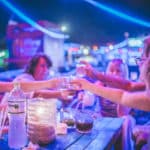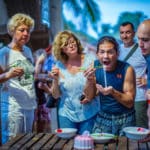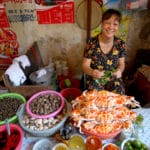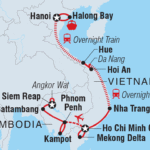Vietnam & Cambodia Real Food Adventure
Chop, slice and chomp your way through the diverse flavours of South East Asia on this mouth-watering adventure into Vietnam and Cambodia. Vietnam’s prized cuisine is bursting with fresh, spicy and complex flavours, while across the border, Cambodia’s food is humble, often unexplored and no less delicious. Drink in cafes and beer halls that sprawl out over city streets, buy fruit from wicker baskets draped over a vendor’s shoulders and sit at market stalls as aromatic noodle soups are whipped up in front of you. From a sunset cruise on Ha Long Bay and a cycle past herb farms near Hoi An to discovering the French influence of Phnom Penh and meeting charming local communities at Preah Dak, these South East Asian powerhouses will fill you with great food and even more memorable experiences.
19 days, from
$3,726
per person
GROUP SIZE
ACTIVITY LEVEL
Details
Countries Visited:
Cambodia
Vietnam
Accommodation: Homestay (1 night), Hotel (14 nights), Overnight Boat (1 night), Overnight Sleeper Train (2 nights)
Transportation: Overnight Sleeper Train , Plane , Private Vehicle , Taxi
Included Meals:
- 15 breakfasts
- 7 lunches
- 8 dinners
Group size: Minimum 1, Max 12
Minimum Age: 15
Embrace your adventurous side on a tour of Hue’s imperial monuments from the back of a motorbike (the local way of getting around). Then be treated to lunch, specially prepared for you by a chef who is the descendant of the royal family in the garden of their family home.
Two true bucket list experiences - sail through Halong Bay’s limestone karsts and island caves and explore Angkor Wat’s many temples with a local expert guide.
Don’t just taste your way around these foodie havens, don your chef hat and learn the recipes behind these incredible eats, too. Learn the secret spices directly from local chefs (often in their own homes) and be guided to the freshest ingredients in authentic local markets.
Homestays in the village of Banteay Chhmar and the Mekong Delta put you right in the heart of rural life, with the best fresh produce on your doorstep.
Discover the real flavours of Vietnam and Cambodia, digging into authentic eats like pho, banh mi, bun cha, fish amok and beef lok lak – a true feast for the senses.
Itinerary
Xin chao! Welcome to Vietnam. Your adventure begins in the country’s capital of Hanoi. You’ll meet your group and leader for an important welcome meeting at 6 pm and then head out for your first introduction to Vietnam’s lively culinary scene. Your leader will take you to a local restaurant for your first group dinner this evening where you might like to take the chance to sink your teeth into bun cha, a grilled pork and noodle dish that’s loved in Hanoi.
After breakfast this morning, head out for a guided tour of Chau Long Market. Here, you’ll get a real taste for local life and learn about the secret ingredients and flavours of northern Vietnamese cuisine. Our hot tip – be sure to sample the local coffee, typically served with condensed milk, or for the more adventurous, egg! You’ll also get the chance to tuck into some of Hanoi's renowned street food specialties, with your local leader guiding you (and your tastebuds) in the right direction. Once you've filled up on traditional Vietnamese street eats, the afternoon and evening are yours to spend however you wish. Perhaps, make your way to the Old Quarter to explore the lively back streets or discover some of Hanoi’s historical sites like One Pillar Pagoda in the Ba Dinh district.
This morning, hit the road for the spectacular World Heritage-listed site of Halong Bay. The harbour, with approximately 2000 limestone islands rising from the turquoise waters of Bac Bo Gulf, spans an area of about 1500 square kilometres and is dotted with beaches and grottos. On arrival, you’ll set sail on the emerald-green waters, gliding between limestone karsts to take in the incredible scenery from the best outlook of them all - on the water. Then, you’ll explore Surprise Cave, one of the most striking caves in Halong Bay, covering an area of more than 12,000 square meters. In the afternoon, you’ll return to your boat and enjoy a delicious feast prepared by an onboard chef. Tonight’s stay is something special as you’ll be sleeping on the traditional boat, letting the water lull you to sleep and really taking in the beauty of the surrounding bay.
You’d be forgiven for thinking you were still dreaming when you wake up on the bay this morning. If you’re an early riser, you might like to organise an optional kayak experience before you head back to Hanoi this morning. On arrival back in Hanoi, you’ll board an overnight train bound for Hue. Although conditions are basic, overnight trains are a rewarding experience. It's an efficient way to travel long distances and a great way to get a sense of the country. Most trains have a dining carriage serving simple food, but we recommend asking your leader for advice on which local salty and sweet snacks to stock up on, prior to departure.
Welcome to Hue. This city is Vietnam’s former royal capital, and its cuisine is considered by many Vietnamese as the best in the country. The food is influenced by its imperial heritage (small dishes and a focus on aesthetic presentation) and its strong Buddhist heritage, reflected in the high proportion of vegetarian restaurants in the area. After leaving your luggage at your hotel, embark on a tour of the city’s imperial monuments from the back of a motorbike. Stop past Thien Mu Pagoda, an active Buddhist monastery since 1601, where you'll see a car that belonged to one of the self-immolating monks of the 1963 protests. After some time exploring, you’ll take a dragon boat cruise on the Perfume River before stopping for a special plant-based Buddhist lunch. You’ll enjoy a meal specially prepared for you by a chef who is the descendant of the royal family, in the garden of their beautiful family home. After a delightful meal, you’ll finish your day of sightseeing with a visit to the royal tomb of Emperor Tu Duc. Then, the evening is free for your own food adventure. Perhaps ask your leader for the best place to try imperial street specialties like banh hue (rice flour cakes stuffed with shrimp, pork and spices).
After a local breakfast of bun bo hue – a spiced beef noodle soup – it’s time to visit the Imperial Citadel, which includes the Forbidden Purple City. The latter was almost totally destroyed during the Vietnam War's Tet Offensive, but the foliage-covered ruins are still atmospheric, and the gaping holes left by bombs give an idea of the destruction wreaked upon the country during the war. Head south by bus through coastal rice paddies and traverse the mountainous Hai Van Pass to Hoi An. This beautifully restored city retains the feel of centuries past, making it the sort of place that grows on you the more you explore it. After some time to settle into your hotel, you’ll make your way to a special beachside restaurant for a seafood hotpot dinner with your group. This is a particularly popular meal amongst the locals in Hoi An – dig in!
Today, you’ll really get to know Hoi An, with a day filled with authentic experiences. First up, your leader will take you on an orientation walk around the Ancient Town. Then, you’ll discover Reaching Out Tea House, a non-government organisation that supports the local deaf and mute community by providing employment and vocational training. The peace and quiet of this café stands in stark contrast to the bustling streets outside. While here, you’ll sip delicious teas in total silence – a tranquil experience you won’t soon forget. After a little time to relax, you’ll get ready for a cooking class with a local chef this afternoon. You’ll be escorted to a local market to shop for fresh ingredients and then taken through a culinary journey with hands-on demonstrations. Your local chef will even share the stories behind the yin and yang elements, unveiling the secret of home-cooked Vietnamese meals. Feast on your delicious creations, dishes that highlight the cooking of the Pho Hoi people.
Today is free for you to explore Hoi An at your leisure and of course your leader can recommend the best food and activities. For early risers, take the opportunity to visit the Hoi An fish markets – they are at their most vibrant in the mornings. Afterwards, if the weather's fine, perhaps hit the local beach for a swim (a great way to get there is by bicycle, which you can hire in town). In the evening, you could enjoy some seafood by the water, or jump on a boat for a barbecue feast on a nearby island.
Take a short flight to Ho Chi Minh City, then join a guided tour to get a feel for the city's frenetic, fascinating blend of old and new, East and West. You will notice a strong French influence in Ho Chi Minh City, which means excellent coffee and baguettes – lucky for you, you’ll get a taste for their delicious iced-coffee and pork belly banh mi at lunch today. Then, you’ll stop past the War Remnants Museum, GPO and Notre Dame Cathedral, finishing up at one of Vietnam’s most pulsing markets, Ben Thanh. This is the perfect place to pick up any last-minute snacks, cooking utensils, ingredients, or presents for friends and family. Tonight, take part in a cooking class where you'll learn some contemporary twists on traditional Vietnamese dishes with a passionate chef. Sit down and enjoy the delicious feast you've prepared over dinner.
After breakfast this morning, kiss Ho Chi Minh City goodbye as we make our way to the Mekong Delta. The delta is known as ‘Vietnam’s rice bowl’ for its abundance of rice paddies, fruit and flower orchards. Once you arrive, you’ll hit the water and cruise up this mighty river, stopping at tropical fruit gardens and local cottage industries to sample honey, coconut candy and fruit, right at the source. Enjoy being paddled slowly along the quieter backwaters in a sampan, one of the most common forms of transport in these parts. Continue to your homestay for this evening. Meet your hosts and take some time to wander the garden, relax or lend a hand with dinner preparations. Enjoy a southern Vietnamese feast on the wide veranda overlooking the garden as the sun goes down.
For those who fancy an early morning cycle, join your hosts on a ride to the nearby village market for breakfast supplies for the group, and then enjoy a meal back at the homestay. After breakfast, the whole group will visit a local market before boarding the boat back to Vinh Long to return to Ho Chi Minh City by bus. Once we arrive, the rest of the day is at your leisure. You may like to enjoy a final Vietnamese meal with your new friends or enjoy a drink at one of the city’s iconic rooftop bars.
Check out of your hotel this morning and transfer to the airport for an unaccompanied flight to Phnom Penh. The flight will take around 50 minutes, after which you'll be met by another transfer driver who will take you to your hotel. The Cambodian section of your Real Food Adventure begins tonight with an important welcome meeting at 6 pm, where you'll get to meet your new leader and travel companions. Phnom Penh is set at the confluence of the Mekong and Tonle Sap rivers, and life centres around the lively river-front area where the locals come to take in the air, snack on street food and enjoy the unfolding waterside entertainment. Food in Cambodia combines an eclectic mix of local and international influences and has a flavour all its own. Kick off this food adventure at an inspirational hospitality school that provides vocational training for former street youths in Phnom Penh. It’s a great opportunity to sample some tasty modern Cambodian cooking. After dinner, you might like to grab a relaxing drink at the Foreign Correspondents' Club, or stroll along the well-known Sisowath Quay with some new travel pals – it’s up to you.
Take a morning cyclo (cycle-rickshaw) tour around Phnom Penh, discovering some of the interesting sights, sounds and smells of the capital, including the wonderful art deco-designed Psar Thmei (Central Market). Along the way, taste some of the best street food in the city, like sticky rice with beans wrapped in banana leaf and spiced fried crickets!
Back to the hotel to freshen up, and check out. Before you leave Phnom Penh, confront Cambodia's tragic past on a guided tour of the Tuol Sleng Genocide Museum, located in a former high school that served as the notorious Security Prison 21 (S-21) for the Khmer Rouge regime from 1975 to 1979.
You will also stop past the Killing Fields of Choeung Ek which represent the tragic legacy of the Khmer Rouge. Afterwards, drive south by private vehicle, towards Kampot, one of Cambodia's most attractive old towns (approximately 3 hours). Arrive in Kampot by evening.
Famous for its pepper, Kampot supplied most French restaurants for many years during colonial rule. Today, the region is also renowned for its durian, a spiky, pungent fruit that either incites adoration or sheer loathing. Try it if you dare! In some free time, you might stroll along the riverside's French colonial architecture, or enjoy a coffee on the veranda of a riverside restaurant and admire the Bokor Mountain Range.
After breakfast take a tour of the countryside, tasting locally-grown, seasonal produce. Depending on the season, you'll be treated to durian or rambutan, plus lychee, pineapples, mangos or bananas. Next, visit the Kampot Pepper Project. Grown in Cambodia for centuries, Kampot pepper is considered among the world’s finest. Today pepper is also seen as an important symbol of Cambodian regeneration – the province’s pepper was almost completely wiped out by rice production during the Khmer Rouge period. Continue on to the lively Kep Crab markets, where crabs are kept fresh in pots that float in the Gulf of Thailand's warm waters. Enjoy a lunch of fresh crab cooked to perfection, eaten on a pier overlooking the ocean. After lunch, walk along the Kep beach and explore the old oceanfront buildings. Kep was once Cambodia's most popular and prestigious beach town, but the Khmer Rouge destroyed many of Kep's mansions and villas. The ghostly remains now stand as a silent reminder. Alternatively, relax in a hammock or swim in the warm South China Sea.
Rise early to see the fishing boats arrive at the port with their daily catch. For breakfast, perhaps partake in a meal of crab, prawns or squid cooked up with Kampot green peppercorns and served with rice is. Alternatively try some of Kampot's tastiest baguettes on a visit with the owner of a small wood fired oven. This legacy of French colonization is ubiquitous – many roadside carts sell baguettes with meat, sauces and salad as a snack for workers.
After breakfast you’ll return to Phnom Penh (approximately 3.5 hours).
Meet a passionate chef for a guided tour of the markets, learning about the building blocks of Khmer cuisine. Enjoy a hands-on cooking class and master Khmer staples such as Samlor Machou Yuon (sour "Vietnamese" soup with fresh fish and tamarind) or Bok Svay (pounded green mango salad, usually served with dried fish or prawn). Feast on your creations over dinner.
Travel by private bus to Battambang (approximately 6-7 hours including several stops). Cambodia's second-largest city, Battambang (pronounced Battambong), is a pretty riverside town of French elegance, friendly Khmer people and beautifully preserved colonial architecture. The city is famous for its many statues of animals and divinities that decorate the streets and buildings. It also lacks the traffic of Phnom Penh and the visitor numbers of Siem Reap, so it’s a great place to get a real slice of Cambodia. Your leader can recommend activities for your free afternoon. Perhaps join a local Battambang foodie for a home-cooked meal, tasting local dishes such as amok, Khmer curry, and fried spicy chicken with homemade rice noodles.
Take a bicycle ride into the countryside. The ride is easy and takes in mostly shady roads through local villages. Along the way, stop and experience rice paper-making, fruit drying and preparation, production of the famous prahok (fish paste) and rice wine-making. Finish up at the best Kralan (sticky rice in bamboo) stall in the district. Then travel by private bus to the temple city of Banteay Chhmar, sometimes referred to as the Citadel of the Cat (approximately 3-4 hours). Some of the road is unsealed which slows down the journey, but it is worth it to visit this remote small community. The 9th century temple here is a top candidate for World Heritage Status, with the ruins here similar to the famous Bayon with their face towers, and surrounded by an impressive 9 kilometre-long wall. Experience true Cambodian hospitality by staying with a local family in a traditional Khmer wooden-stilted house. As the day draws to a close, enjoy a memorable traditional Khmer dinner by torch-light in the grounds of the temple. If traveling during the rainy season the temple grounds may be too wet so we will instead visit a local Community Center for a traditional dinner.
Rise early for a morning temple visit. After a traditional Khmer breakfast, take a turn around the village food market with your local hosts. Select fresh vegetables, meat and herbs and help prepare a delicious lunch with your community hosts, picking up a cooking tip or two! After your lunchtime feast, depart for Siem Reap by private vehicle (approximately 4 hours). The small but expanding town of Siem Reap is the gateway to Angkor. This is the most popular destination for travellers in all of Cambodia, perhaps even in South East Asia. You'll probably notice a change of pace here, so take a short introductory walk around the centre of town and enjoy the atmosphere. With its cafes, bars, restaurants, food and drinks stands, Siem Reap caters for foodies of all persuasions. In the evening, take a motor remork around the hidden local street food treasures of Siem Reap: barbecued corn and meat on skewers; Khmer Fried Chicken; green mango served with chilli and salt; ducks eggs and more. Finish at a dessert stall where fruit shakes, fruit with sweetened condensed milk and baked puddings are the specialty.
Spend a full day temple-hopping with your local guide to make the most of your visit to the world-famous Angkor complex, built between the 9th and 13th centuries when the Khmer empire was the pre-eminent influence in Southeast Asia. The ruins are scattered over an area of some 160 square kilometres, but the main cluster of temples is close to Siem Reap so you'll have plenty of time to fully appreciate the great archaeological sites. These include Angkor Wat, Bayon and the jungle-covered Ta Prohm. The temples were believed to represent the cosmic world and were set in perfect balance, symmetry and composition. The intricately carved bas-reliefs and architectural designs are mind-blowing and there are spectacular photographic opportunities at any time of day. In the evening, enjoy a final dinner at a plant-based restaurant celebrating contemporary Khmer flavours. Using fresh produce from their own gardens, tuck into dishes like mushroom lok lak or rice noodle soup.
Your Real Food Adventure comes to an end this morning. There are no activities on your final day and you are free to leave at any time. If you are keen to continue your exploration of the Angkor complex, please speak with your leader about extending the length of your access pass.








